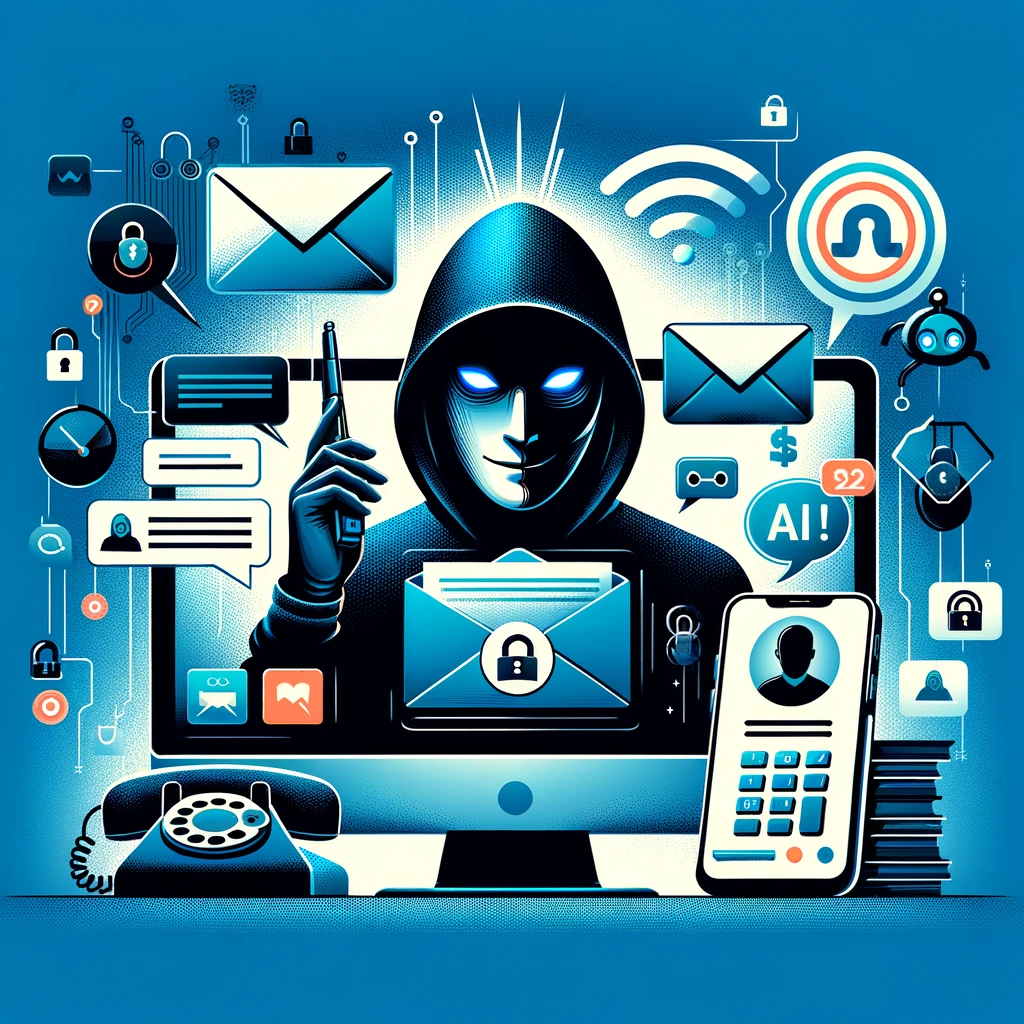In today’s digital landscape, cybercriminals continuously adapt their tactics to exploit vulnerabilities and gain unauthorized access to sensitive information. One emerging threat is AI-powered vishing (voice phishing) and deepfake phishing attacks. Utilizing machine learning algorithms, these sophisticated attacks can deceive even the most cautious individuals.
AI-Powered Phishing Attacks
Phishing traditionally involves deceptive emails, messages, or websites designed to trick users into revealing sensitive information like passwords or financial details. Advances in AI have made these attacks more sophisticated.
AI technology enables attackers to generate highly personalized and realistic phishing messages by analyzing an individual’s communication patterns, vocabulary, and tone. This allows for messages that mimic the writing style of colleagues or senior managers, significantly increasing the likelihood of a successful attack.
AI tools automate the creation and distribution of phishing attacks, making them more effective and scalable. AI algorithms can manage the entire process, from crafting phishing emails to disseminating them across platforms like email, social media, and messaging apps.
Common AI-Powered Phishing Tactics:
- Identity Theft: Highly convincing messages make it easier for cyber thieves to steal personal information.
- Financial Fraud: These attacks can trick victims into fraudulent wire transfers or purchasing fake products.
- Malware Delivery: AI-enhanced phishing emails can deliver malware, leading victims to inadvertently download malicious attachments.
- Reputational Damage: Successful attacks can erode customer and stakeholder trust, damaging an organization’s reputation.
AI-Powered Vishing Attacks
Vishing (voice phishing) and deepfake phishing attacks leverage advanced technologies to deceive and manipulate victims more effectively. It involves fraudulent phone calls where attackers impersonate trusted entities, exploiting the inherent trust in voice communication. Deepfake technology uses AI to create highly realistic audio or video content that mimics real individuals. In phishing contexts, deepfakes convincingly impersonate executives, colleagues, or trusted figures.
How Deepfake Vishing Works:
- Data Collection: Attackers gather audio and video samples of the target from public sources like social media or company websites.
- Deepfake Creation: AI algorithms generate a deepfake that accurately replicates the target’s voice and appearance.
- Phishing Attack: Attackers use the deepfake to create convincing audio or video messages, tricking victims into revealing sensitive information or performing specific actions.
Impact on Various Sectors
Different industries face varying levels of risk from AI-powered phishing and vishing attacks:
- Finance and Insurance: These sectors saw a 393% increase in phishing attacks due to the high value of financial data.
- Manufacturing: With a 31% increase in phishing attacks, digitized and interconnected manufacturing processes present more opportunities for cybercriminals.
- Healthcare: The sensitive nature of patient data makes healthcare a prime target for AI-powered phishing attacks.
- Retail and E-commerce: The vast amounts of consumer data and online transactions in these sectors make them highly vulnerable.
Top Countries and Leading Brands Targeted by Phishing
In 2023, the United States (55.9%), United Kingdom (5.6%), and India (3.9%) were the top targets for phishing scams. The high incidence in the US is due to its advanced digital infrastructure, large population of internet-connected users, and extensive online financial transactions.
Canada (2.9%) and Germany (2.8%) also ranked among the top five countries experiencing the most phishing attempts. Most phishing attacks originated from the US, the UK, and Russia, while Australia entered the top 10 with a 479% year-over-year increase in phishing content hosted within the country.
Microsoft’s platforms, including OneDrive and SharePoint, were the most frequently targeted due to their widespread use.
Other frequently targeted brands included:
- Google: With 18% of all brand impersonation attempts.
- PayPal: Common target for financial phishing scams, accounting for 12% of attacks.
- Amazon: Subject of 10% of phishing attacks.
- Apple: Frequent target, comprising about 8% of phishing attempts.
- Netflix: Involved in around 5% of attacks.
Mitigation Strategies
To combat AI-powered phishing and vishing attacks, organizations should adopt a proactive and layered cybersecurity approach:
- Security Audits: Conduct regular audits to identify and address vulnerabilities.
- Employee Education: Train employees to recognize and report suspicious emails, verify email addresses and URLs, and understand the risks.
- Advanced Email and Web Security Solutions: Deploy cybersecurity solutions to detect and block phishing attempts before they reach end-users.
- Implement Zero Trust Architecture: Ensure no entity inside or outside the network is trusted by default, minimizing the risk of phishing attacks.
- Incident Response Planning: Develop a robust incident response plan to quickly and effectively respond to phishing attacks.
- Secure Communication Channels: Ensure communication channels are secure to prevent phishing attacks that rely on intercepting or spoofing communications.
- Threat Intelligence: Utilize threat intelligence services to stay informed about the latest phishing tactics and emerging threats.
- Phishing Simulations: Conduct regular phishing simulation exercises to test employee awareness and response to phishing attempts.
- Access Controls: Implement strict access controls to limit the permissions of users and applications, reducing the potential impact of an attack.
Conclusion
AI-powered phishing and vishing attacks pose a significant and evolving threat to organizations worldwide. By understanding these threats and implementing robust security measures, businesses can protect themselves against these sophisticated attacks. Regular updates, employee education, and advanced cybersecurity technologies are essential components of an effective defense strategy.

